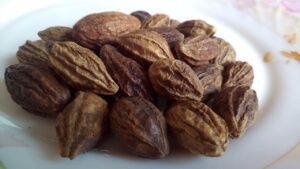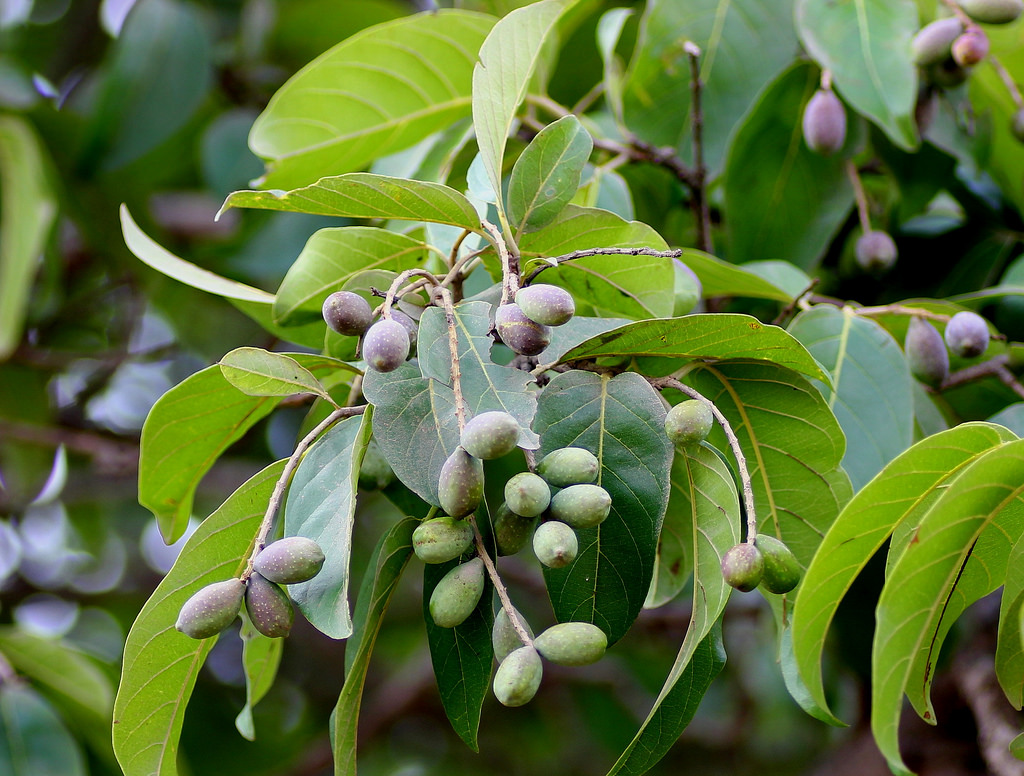Herb
Haritaki (Terminalia chebula) Herb Ayurvedic Overview
Haritaki (Terminalia chebula) is one of the most vital drugs in Ayurveda, often claimed as “King of Medicine” and used in vastly Ayurvedic formulations and as a particular drug too. Haritaki is one of the crucial three parts of Triphala (translate to three fruits), a well-known polyherbal Ayurvedic formulation.
Haritaki comprises the pericarp of mature fruits of Terminalia chebula Retz. (Fam. Combretaceae), which is a moderate-sized or large tree found throughout India. It is majorly found in deciduous forests and areas of light rainfall and occasionally found in moderately moist forests, up to about 1500 m elevation; throughout India, flowers appear from April till August, and fruits ripen from October till January.
Terminalia chebula is looked upon as adoration for its clinical properties and essential use. It is abundant in Vitamin C and does have anti-oxidant and anti-inflammatory properties. Information on this drug is present in all Ayurvedic classical textbooks and materia medica of Ayurveda. Haritaki has been recommended for external wound healing and internally as a Rasayana for the digestive system. It promotes digestion, enhances weight loss, manages oral hygiene, diabetes, and nourishes hair and skin. It is contemplated as Tridoshik, meaning it balances all the three doshas (Vata, Pitta, and Kapha) and brings them to their samaawastha.
Table of Contents
Scientific Classification of Haritaki (Terminalia chebula):
- Kingdom: Plantae
- Subkingdom: Tracheobionta
- Division: Magnoliophyta
- Superdivision: Spermatophyta
- Class: Magnoliopsida
- Subclass: Rosidae
- Order: Myrtales
- Family: Combretaceae
- Genus: Terminalia L.
- Species: Terminalia chebula (Gaertn.)
Haritaki (Terminalia chebula) Synonyms:
- Sanskrit: Abhaya, Kayastha, Siva, Pathya, Vijaya
- Assamese: Shilikha
- Bengali: Haritaki
- English: Myrobalan
- Gujrati: Hirdo, Himaja, Pulo-harda
- Hindi: Harre, Harad, Harar
- Kannada: Alalekai
- Kashmiri: Halela
- Malayalam: Katukka
- Marathi: Hirda, Haritaki, Harda, Hireda
- Oriya: Harida
- Punjabi: Halela, Harar
- Tamil: Kadukkai
- Telugu: Karaka, Karakkaya
- Urdu: Halela
Haritaki (Terminalia chebula) Description:
 a) Macroscopic:This drug is intact fruit yellowish-brown and is ovoid. It is 20-35 mm long, 13-25 mm wide, is wrinkled and ribbed longitudinally, pericarp fibrous, consisting 3-4 mm thick, and non-adherent to the seed, astringent, and taste.
a) Macroscopic:This drug is intact fruit yellowish-brown and is ovoid. It is 20-35 mm long, 13-25 mm wide, is wrinkled and ribbed longitudinally, pericarp fibrous, consisting 3-4 mm thick, and non-adherent to the seed, astringent, and taste.
b) Microscopic: Transverse section of pericarp indicated epicarp consisting of one layer of epidermal cells inner tangential and upper portions of radial wall thick, the mesocarp, having 2-3 layers of collenchyma which is followed by a parenchyma in which the fibers and sclereids in group and vascular bundles scattered, the threads with peg-like outgrowth and simple pitted walls.
The sclereids of various shapes and sizes but essentially elongated, tannins and raphides in the parenchyma, endocarp consists of thick-walled sclereids of different shapes and sizes, which are primarily elongated, the epidermal surface view does reveal polygonal cells, the uniformly thick-walled and several of them divided into two by a thin septum, starch grains simple rounded or 62 oval in shape, measuring around 2-7 µ in diameter and are found in plenty in almost all cells of mesocarp.
Identity, Purity, and Strength of Haritaki (Terminalia chebula):
- Foreign matter Not more than 1 percent, Appendix 2.2.2.
- Total Ash Not more than 5 percent, Appendix 2.2.3.
- Acid-insoluble ash Not more than 5 percent, Appendix 2.2.4.
- Alcohol-soluble extractive Not less than 40 percent, Appendix 2.2.6.
- Water-soluble extractive Not less than 60 percent, Appendix 2.2.7.
Chemical Constituents of Haritaki (Terminalia chebula):
Terminalia chebula consists of tannins, anthraquinones, and polyphenolic compounds. Haritaki also has twelve fatty acids, including oleic acid, linoleic acid, and palmitic acid.
Ayurvedic Properties and Action of Haritaki (Terminalia chebula):
- Rasa : Madhura, Amla, Katu, Tikta, Kasaya
- Guna : Laghu, Ruksha
- Virya : Ushna
- Vipaka : Madhura
- Karma : Caksusya, Dipana, Hrdya, Medhya, Sarvadosaprasamana, Rasayana,
- Anulomana
Ayurvedic Formulation made by Haritaki (Terminalia chebula):
Haritaki is used in making these formulations, as mentioned in Classical Ayurvedic Textbooks and Materia Medica of Ayurveda. Triphala Curna, Triphaladi Taila, Abhayarista, Agastya Haritaki Rasayana, Citraka Haritaki, Danti Haritaki, Dasamula Haritaki, Brahma Rasayana, AbhayaLavana, Pathyadi Lepa.
Therapeutic Uses of Haritaki (Terminalia chebula):
Haritaki (terminalia chebula) can be used in various conditions like Shotha, Arsha, Aruchi, Hrdroga, Kasa, Pandu, Prameha, Udavarta, Vibandha, Jeernajwara, Vishamajwara, Siroroga, TamakaShwasa, Gulma, UdaraRoga.
Dose of Haritaki (Terminalia chebula):
3-6 gm of the drug in powder.
Reference:
Ayurvedic Pharmacopeia of India.
For regular health updates, please follow our Social Pages


